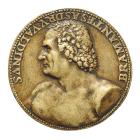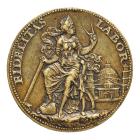Cristoforo di Giovanni Matteo Foppa, known as “Caradosso”, Medal of Donato Bramante
Cristoforo di Giovanni Matteo Foppa, known as “Caradosso” (Mondonico, circa 1452-Roma, circa 1527), Medal of Donato Bramante
Cristoforo, who took the name of his native town, was a goldsmith, sculptor and medallist and son of the goldsmith Gian Maffeo. After a period working in Rome, in 1475 he entered the service of the Sforza family of Milan and became a consultant for the Fabbrica del Duomo. He soon acquired great fame and was celebrated, among other things, for the engraved inkstand made for the study of Isabella d'Este. It was a vase formed by about fifty pieces of crystal and an engraved silver inkstand decorated with bas-reliefs depicting mythological scenes, such as the Rape of Ganymede, Hercules and Cacus, and Hercules and the Nemean lion.
In 1505 he returned to the papal court in Rome, working for Pope Julius II, Leo X and Clement VII, where he met Benvenuto Cellini, who praised the artist both in person and in the Goldsmith Treatise, for the quality of workmanship of his medals.
Of the many works produced, today some medals of great technical sophistication, informed by robust plasticity and attentive to the examples of the late Roman period are well known. These compositional elements are evident in the frontal view portrait of a naked torso by Donato Bramante; the reverse of the medal shows the allegory of Architecture. This frontal and reversed view is also inspired by a classical image, but is the result of a profound and original reworking of descriptive models.









